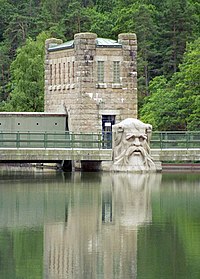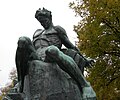Carl Eldh: Difference between revisions
No edit summary |
No edit summary |
||
| (44 intermediate revisions by 37 users not shown) | |||
| Line 1: | Line 1: | ||
{{short description|Swedish artist and sculptor}} |
|||
| ⚫ | |||
{{more footnotes|date=March 2023}} |
|||
| ⚫ | |||
'''Carl Johan Eldh'''<ref>signs on artwork as "''C.J. ELDH''"</ref> (10 May 1873 – 26 January 1954) was a [[Sweden|Swedish]] artist and sculptor. |
|||
==Biography== |
|||
'''Carl Eldh''' (1873 - 1954) was a [[Sweden|Swedish]] artist and sculptor. Full name: Carl Johan Eldh (signs on artwork as "''C.J. ELDH''"). Brother to Albert Eldh. |
|||
| ⚫ | Eldh was born in [[Östhammar Municipality]], [[Uppland]], the son of Jan Petter Eldh, a blacksmith, and his wife Maria (née Wickman). His younger brother was the artist [[:sv:Albert Eldh|Albert Eldh]]. From 1897 through 1904 he studied sculpture at the [[Académie Colarossi]] in Paris, where the French sculptor [[Auguste Rodin]] inspired him greatly. His first works were characterized by softer forms, but by 1916 he had developed a powerful realistic style, as with the Strindberg Monument in [[Tegnérlunden]] in Stockholm. Strindberg was a frequent subject for Eldh. |
||
| ⚫ | |||
| ⚫ | Eldh |
||
| ⚫ | Carl Eldh ranks along [[Carl Milles]] with the most popular Swedish sculptors of the first half of the 20th century. Eldh also produced architectural sculpture with renowned Swedish architects, among them [[Ivar Tengbom]], [[Erik Lallerstedt]] and [[Ragnar Östberg]]. Östberg designed Eldh's own studio in Bellevue Park, in the north of Stockholm, in 1918. It was through Östberg that Eldh received the 1923 contract for park sculptures for the Stadshuspark. |
||
| ⚫ | |||
| ⚫ | Adjacent to [[Stockholm City Hall]], between the building and the shore of Lake Mälaren's shore, the park stands with Eldh's ensemble representing the three artists, [[August Strindberg]] for Authors, [[Gustaf Fröding]] for Poets, and [[Ernst Josephson]] for Painters, as well as Eldh's [[bronze]] sculptures "Sången" and "Dansen" ("The Song" and "The Dance"). The nakedness of the statues initially caused strong protests.{{cn|date=March 2023}} |
||
| ⚫ | Carl Eldh ranks along [[Carl Milles]] with the most popular Swedish sculptors of the first half of the 20th |
||
| ⚫ | Eldh’s major public works include the grand statue of [[August Strindberg|Strindberg]] in [[Stockholm]] and [[the Branting Monument]], also in Stockholm, which was first executed in plaster around 1930 and completed in 1952. His work was also part of the [[Art competitions at the 1932 Summer Olympics#Sculpture|sculpture event]] in the [[Art competitions at the 1932 Summer Olympics|art competition]] at the [[1932 Summer Olympics]].<ref>{{cite web|url=https://www.olympedia.org/athletes/921339 |title=Carl Eldh |work=Olympedia |accessdate=8 August 2020}}</ref> |
||
| ⚫ | Adjacent to [[Stockholm City Hall]], between the building and the shore of Lake Mälaren's shore, the park stands with Eldh's ensemble representing the three artists, [[August Strindberg]] for Authors, [[Gustaf Fröding]] for Poets, and [[Ernst Josephson]] for Painters, as well as Eldh's [[bronze]] sculptures "Sången" and "Dansen" ("The Song" and "The Dance"). The nakedness of the statues initially caused strong protests. |
||
| ⚫ | The Carl Eldh studio in [[Bellevue (Stockholm)|Bellevue]] is now a public museum, "Carl Eldh Ateljémuseum", with two studio rooms stocked from floor to ceiling with drawings, sculptures, tools and other personal belongings. A visit reflects not only on the creative activity of an individual sculptor, but allows direct study of his era. |
||
| ⚫ | |||
| ⚫ | |||
== Images == |
== Images == |
||
| Line 20: | Line 22: | ||
Image:Stadshusparken Strindberg.jpg|Strindberg |
Image:Stadshusparken Strindberg.jpg|Strindberg |
||
Image:Danielsson.o.palm.jpg|Detail of |
Image:Danielsson.o.palm.jpg|Detail of [[The Branting Monument]] |
||
Image:Eldstrindbergmonument.jpg|Strindberg Monument, in [[Tegnérlunden]], Stockholm |
Image:Eldstrindbergmonument.jpg|Strindberg Monument, in [[Tegnérlunden]], Stockholm |
||
Image:Carl_Eldh_2006a.jpg|Carl Elds Ateljémuseum, designed by [[Ragnar Östberg]] |
Image:Carl_Eldh_2006a.jpg|Carl Elds Ateljémuseum, designed by [[Ragnar Östberg]] |
||
Image:Fabian månsson byst carl eldh.JPG|Bust of [[Fabian Månsson]], 1940 |
Image:Fabian månsson byst carl eldh.JPG|Bust of [[Fabian Månsson]], 1940 |
||
Image:CJEldh01.JPG| |
Image:CJEldh01.JPG|Sculpture in Filmstaden Råsunda |
||
Image:Strindberg Bellevue.JPG|Strindberg statue in [[Bellevue (Stockholm)|Bellevue]] |
|||
File:Statue_of_Gunnar_Wennerberg_in_Minnehaha_Park_2023-06-18.jpg|Statue of [[Gunnar Wennerberg]] in [[Minnehaha Park]], Minneapolis |
|||
</gallery> |
</gallery> |
||
{{ |
{{commons category|Carl Eldh}} |
||
==Notes and references== |
|||
{{reflist}} |
|||
==Sources== |
|||
* Åsa Cavalli-Björkman, Petra Gröminger: ''Carl Eldhs Ateljémuseum. Stiftelsen Carl och Elise Eldhs ateljé'', Stockholm 2005, {{ISBN|9163172968}} |
|||
* Karl Asplund: ''Carl Eldh''. Stockholm 1943 |
|||
* ''Konstnärsförbundets årshäfte'', 1904 |
|||
* [https://sverigesradio.se/artikel/5879096 Sveriges Radio: ''Carl Eldhs statyer stulna på kyrkogården'', 3 June 2014] |
|||
==External links== |
|||
| ⚫ | |||
{{Authority control (arts)|country=SV}} |
|||
{{DEFAULTSORT:Eldh, Carl}} |
{{DEFAULTSORT:Eldh, Carl}} |
||
[[Category:1873 births]] |
[[Category:1873 births]] |
||
[[Category:1954 deaths]] |
[[Category:1954 deaths]] |
||
[[Category:People from Östhammar Municipality]] |
|||
[[Category:Architectural sculptors]] |
[[Category:Architectural sculptors]] |
||
[[Category:Swedish sculptors]] |
[[Category:Swedish male sculptors]] |
||
[[Category: |
[[Category:Recipients of the Prince Eugen Medal]] |
||
[[Category:20th-century Swedish sculptors]] |
|||
[[Category:Académie Colarossi alumni]] |
|||
[[de:Carl Eldh]] |
|||
[[Category:Olympic competitors in art competitions]] |
|||
[[sv:Carl Eldh]] |
|||
| ⚫ | |||
Latest revision as of 05:49, 14 March 2024
This article includes a list of general references, but it lacks sufficient corresponding inline citations. (March 2023) |

Carl Johan Eldh[1] (10 May 1873 – 26 January 1954) was a Swedish artist and sculptor.
Biography[edit]
Eldh was born in Östhammar Municipality, Uppland, the son of Jan Petter Eldh, a blacksmith, and his wife Maria (née Wickman). His younger brother was the artist Albert Eldh. From 1897 through 1904 he studied sculpture at the Académie Colarossi in Paris, where the French sculptor Auguste Rodin inspired him greatly. His first works were characterized by softer forms, but by 1916 he had developed a powerful realistic style, as with the Strindberg Monument in Tegnérlunden in Stockholm. Strindberg was a frequent subject for Eldh.

Carl Eldh ranks along Carl Milles with the most popular Swedish sculptors of the first half of the 20th century. Eldh also produced architectural sculpture with renowned Swedish architects, among them Ivar Tengbom, Erik Lallerstedt and Ragnar Östberg. Östberg designed Eldh's own studio in Bellevue Park, in the north of Stockholm, in 1918. It was through Östberg that Eldh received the 1923 contract for park sculptures for the Stadshuspark.
Adjacent to Stockholm City Hall, between the building and the shore of Lake Mälaren's shore, the park stands with Eldh's ensemble representing the three artists, August Strindberg for Authors, Gustaf Fröding for Poets, and Ernst Josephson for Painters, as well as Eldh's bronze sculptures "Sången" and "Dansen" ("The Song" and "The Dance"). The nakedness of the statues initially caused strong protests.[citation needed]
Eldh’s major public works include the grand statue of Strindberg in Stockholm and the Branting Monument, also in Stockholm, which was first executed in plaster around 1930 and completed in 1952. His work was also part of the sculpture event in the art competition at the 1932 Summer Olympics.[2]
The Carl Eldh studio in Bellevue is now a public museum, "Carl Eldh Ateljémuseum", with two studio rooms stocked from floor to ceiling with drawings, sculptures, tools and other personal belongings. A visit reflects not only on the creative activity of an individual sculptor, but allows direct study of his era.
Images[edit]
-
Strindberg
-
Detail of The Branting Monument
-
Strindberg Monument, in Tegnérlunden, Stockholm
-
Carl Elds Ateljémuseum, designed by Ragnar Östberg
-
Bust of Fabian Månsson, 1940
-
Sculpture in Filmstaden Råsunda
-
Strindberg statue in Bellevue
-
Statue of Gunnar Wennerberg in Minnehaha Park, Minneapolis
Notes and references[edit]
- ^ signs on artwork as "C.J. ELDH"
- ^ "Carl Eldh". Olympedia. Retrieved 8 August 2020.
Sources[edit]
- Åsa Cavalli-Björkman, Petra Gröminger: Carl Eldhs Ateljémuseum. Stiftelsen Carl och Elise Eldhs ateljé, Stockholm 2005, ISBN 9163172968
- Karl Asplund: Carl Eldh. Stockholm 1943
- Konstnärsförbundets årshäfte, 1904
- Sveriges Radio: Carl Eldhs statyer stulna på kyrkogården, 3 June 2014







